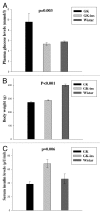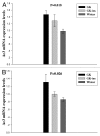Increased expression of adenylyl cyclase 3 in pancreatic islets and central nervous system of diabetic Goto-Kakizaki rats: a possible regulatory role in glucose homeostasis
- PMID: 23018249
- PMCID: PMC3524141
- DOI: 10.4161/isl.22283
Increased expression of adenylyl cyclase 3 in pancreatic islets and central nervous system of diabetic Goto-Kakizaki rats: a possible regulatory role in glucose homeostasis
Abstract
Adenylyl cyclase 3 (AC3) is expressed in pancreatic islets of the Goto-Kakizaki (GK) rat, a spontaneous animal model of type 2 diabetes (T2D), and also exerts genetic effects on the regulation of body weight in man. In addition to pancreatic islets, the central nervous system (CNS) plays an important role in the pathogenesis of T2D and obesity by regulating feeding behavior, body weight and glucose metabolism. In the present study, we have investigated AC3 expression in pancreatic islets, striatum and hypothalamus of GK rats to evaluate its role in the regulation of glucose homeostasis. GK and Wistar rats at the age of 2.5 mo were used. A group of GK rats were implanted with sustained insulin release chips for 15 d. Plasma glucose and serum insulin levels were measured. AC3 gene expression levels in pancreatic islets, striatum and hypothalamus were determined by using real-time RT-PCR. Results indicated that plasma glucose levels in Wistar rats were found to be similar to insulin-treated GK rats, and significantly lower compared with non-treated GK rats. AC3 expression levels in pancreatic islets, striatum and hypothalamus of GK rats were higher compared with Wistar rats, while the levels were intermediate in insulin-treated GK rats. The AC3 expression display patterns between pancreatic islets and striatum-hypothalamus were similar. The present study thus provides the first evidence that AC3 is overexpressed in the regions of striatum and hypothalamus of brain, and similarly in pancreatic islets of GK rats suggesting that AC3 plays a role in regulation of glucose homeostasis via CNS and insulin secretion.
Figures




References
Publication types
MeSH terms
Substances
LinkOut - more resources
Full Text Sources
Medical
